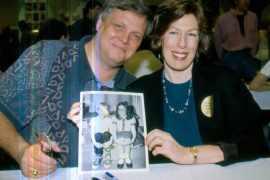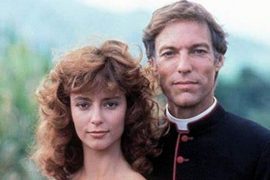 |
| Do you or someone in your family have one of these cards? If so, I’ll trade you straight up for my HBO Game of Thrones screeners |
Dear Mister TV Feeds My Family: How old is television?
Thanks Jimmy from Long Island. Some experts say broadcast television dates back to April 30, 1939–75 years ago this week.
That’s when the folks at Radio Corporation of America–better known as RCA–telecast U.S. President Franklin D. Roosevelt’s opening address at the 1939 New York World’s Fair.
Under the leadership of iconoscope creator Vladimir Zworykin, RCA had been developing TV systems all throughout the ’30s and had a system scanning 441 lines by ’39. They showcased four receiver models for home use at the World’s Fair and had several set up inside their pavilion. One was called a TRK-12 and was in a transparent case so visitors to the fair could see there were no little people inside.
 |
| FDR in ’39: “We have nothing to fear but eleventy billion-million commercials” |
When Roosevelt made history he was watched by a couple of hundred viewers in the pavilion as well as a few dozen more back on the 62nd floor of the RCA building in Manhattan (from a signal bounced off an aerial on the Empire State Building). More people likely saw FDR live at the fair than in front of TV sets.
RCA president David Sarnoff actually beat FDR on TV by ten days, captured on mobile cameras as he dedicated the RCA Pavilion.
All RCA needed now was content. What followed that spring and summer of ’39, apparently, were telecasts of operas, cooking demonstrations, cartoons, fashion shows and shots of skaters at Rockefeller Center.
It’s really the 75th anniversary of the false start of broadcast television. NBC–then a division of RCA–had its TV broadcasts shut down after a few months while the Federal Communications Commission reviewed standards after hearing from competitors. By the time things got back on line–now at 525 lines–it all got shut down again with the outbreak of World War Two.
Or almost all of it. The Dumont Network maintained some kind of a schedule throughout the war years, but it wasn’t until after the war, in 1946, that there were 6000 sets in the U.S. That jumped to 142,000 in ’47 (kiddie puppet show fave Howdy Doody came along that December) and 977,000 by ’48 (with the premiere of Milton Berle’s Texaco Star Theater). By the time I Love Lucy hit the air in the fall of 1951, there were 15,637,000 TV sets in the United States.
Regular TV broadcasting dates back even further in the U.K., to 1929. The BBC used transmitters to broadcast the Baird 30-line mechanical system.While it had to have been a crude, fuzzy picture, that’s still remarkable considering the first sound motion picture films were only beginning to be shown in Britain around that same year.
 |
| Morey Amsterdam in Broadway Open House days. Nothing survives of him on that show |
Crude, limited-line TV pre-dates the RCA system in the U.S., too. Twenty-five years ago, I spoke with Morey Amsterdam (Buddy on The Dick Van Dyke Show) about his earliest memories of television. Amsterdam, known in Burlesque as “The Human Joke Machine,” was for a few months in 1950 TV’s very first late night talk show host as ringmaster on NBC’s Broadway Open House.
Amsterdam’s TV work, however, pre-dates the RCA system. He recalled smearing on very heavy black and white makeup, in order for his features to show up under the hot lights and poor resolution of experimental television in the ’30s.
The guy behind perhaps the earliest system was Philo T. Farnsworth who invented the first electronic television system in the ’20s. He ended up in an ugly patent war with RCA, eventually depicted in Aaron Sorkin’s 2007 Broadway play The Farnsworth Invention. RCA, in fact, had to make a substantial settlement with Farnsworth in 1939 in order to proceed with their World’s Fair showcase and launch.
RCA rival General Electric was experimenting with TV receivers in New York as early as 1928. Bell Telephone has their own system and tested live, intercity U.S. broadcasts in 1927.
Broadcasting didn’t begin in Canada until much later–September of ’52. It was so long ago, the Leafs won the Stanley Cup just the season before. Rogers could have had the rights for fifty-two dollars!
UPDATE: For more on TV at 75, in particular, how the TV landscape is changing, follow this link to a story I’m quoted in by Andre Mayer at CBC News.
 |
| The 1939 New York World’s Fair was the coolest |





